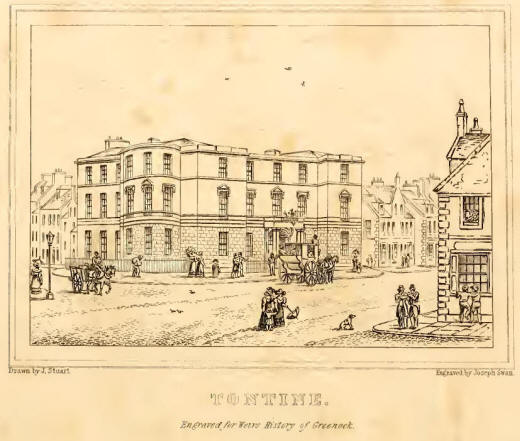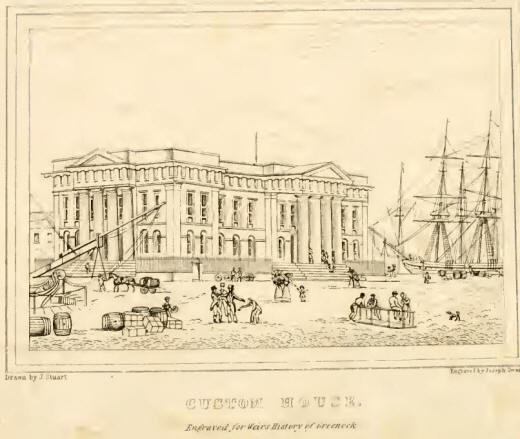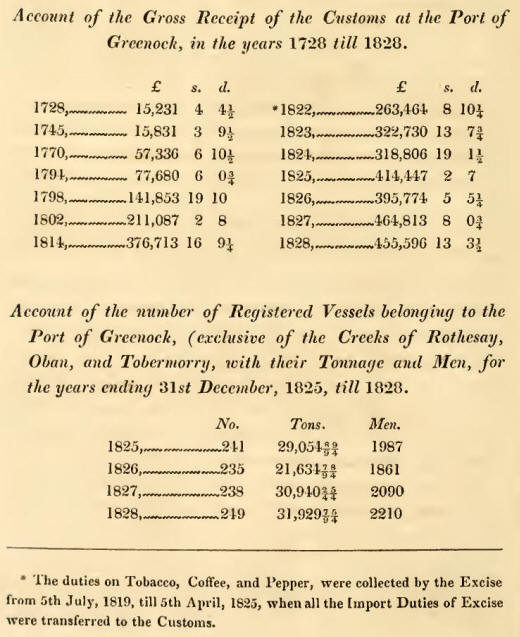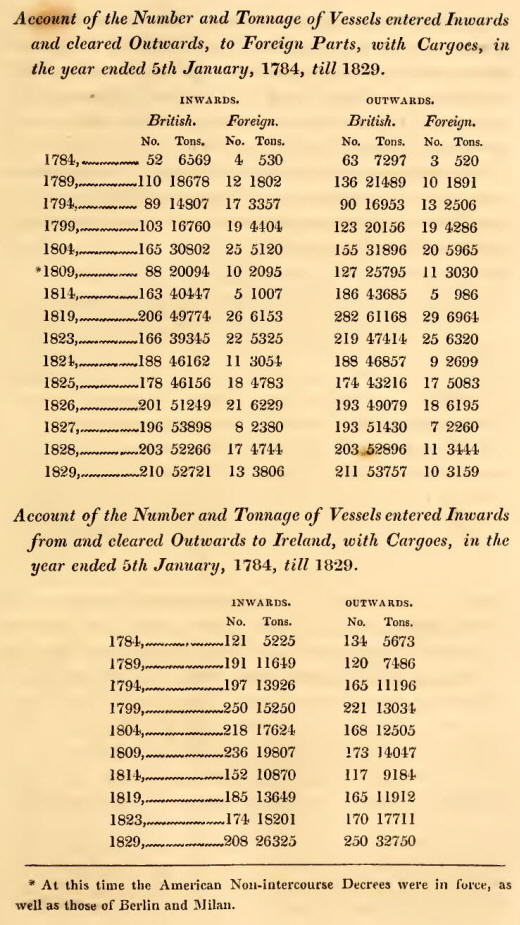In 1801, the Tontine, which is a substantial handsome building, was erected.
It is situated in Cathcart-street, and contains a Large hall, with 12
sitting-rooms and 30 bed-rooms. The subscribers, 400 in number, were
procured in the course of two days; making the subscription, which was £25
per share, amount to £10,000. ln consequence of non-payment, 23 were struck
of the list, which reduced the members to 377, and at this period about 290
are still on the list.
Nearly opposite is situated the Exchange Buildings, which were finished in
1814, at an expense of £7000. This spacious erection, though rather confined
to give it full effect, is a great ornament, to the street. It contains two
Assembly Rooms, which are fitted up in splendid manner; and when lighted and
decorated, and enlivened with the gay assemblage for an evening party, has a
brilliant appearance. The first assembly took place in Alexander's land,
William-street, afterwards in the Town Hall, Star Hall, Buck's head Inn,
Mason Lodge, and Tontine. In lower lane is a large room occupied as the
Coffee Room, which receives a variety of London and provincial papers,
besides the periodicals of the day, and works giving information on
commercial subjects. The expense is defrayed by an annual subscription of
35s., but strangers are admitted without introduction, and are considered as
such for six weeks' residence in town. The first Coffee Room was in the low
flat of Wm. Alexander's great tenement of land in William-street; and if
then limited in its dimensions, had one great advantage in bringing the
subscribers to a close and friendly reciprocity of sentiment. The present
Town Hall was also used for a considerable time for this purpose, and from
thence to its present situation the Coffee Room was removed in year 1814.
The Greenock Bank occupies the western side; and has an extensive business,
not only with London and various commercial towns, but also with the
Highlands and surrounding neighbourhood. This Bank was established under the
firm of Dunlop, Houston & Co., in 1785, and in June of same year their first
hank-note was issued. It was at first situated in the land to

the westward of the Town Hall; from thence it was removed to the Bank
Buildings, West Breast, where it continued till September, 1820. The
sunk-storey has been occupied as a wine-cellar; and, from the coolness and
easy access to it, is generally well employed. Behind this building a small
neat Theatre was built by the late Mr. Stephen Kemble. Previous to this
erection, the lovers of the drama used to assemble near the Rue-end, in that
place occupied as a counting-room, &c., by Robert Angus, Esq. here the
Theatre used to be much frequented; but of late years the taste for this
species of entertainment has been much on the decline, and a full house can
rarely be got when even the London stars pay a visit to the town. This is
not peculiar to Greenock alone; Scotland in general has ceased to bestow its
patronage on amusement which, by its early records, seams to have been any
thing but well received.
The old mansion of the Shaw Stewart family stands upon a fine rising ground
above the Assembly Rooms, and commands a most extensive view of the Town.
This situation, before the buildings encroached upon it, must have been one
of delightful retirement and beauty. There must have been various additions
built to the house since its first erection. An ancient well close by bears
date upon it 1629. Over one of the entrances to the garden is affixed :1635:
but the oldest date in connection with the house is over a hack entrance,
1637.— The front and greater part of the building is of modern erection, and
is said to have been planned by James Watt. It was here, however, that
baronial hospitality spread the board; and from this place John Shaw, with
about 200 of his tenantry, marched to the assistance of King Charles II. and
fought with that prince at the battle of Worcester, 3d September 1631. The
banner which was carried on this occasion, was preserved till about 1796,
and hung along with the Town flags in the Coffee Room, but since this period
was never seen. It was in consequence of the zeal of John Shaw that he was
created a Baronet under the flag on the field of battle. Sir John was
residing here in 1715, and on the Duke of Argyles arrival in Edinburgh on
the 14th September, he addressed a letter earnestly begging assistance.
"From which place and Cartsdyke he was reinforced with somewhat more than
100 men, accompanied by their minister, the Rev. Mr. Turner. These remained
under the orders of his grace for 80 days, doing duty all that time the same
as the regular troops. Besides the above, that were thus employed abroad,
there were 50 men belonging to Greenock, and 25 to Cartsdyke, who kept watch
every iiight, bringing all the boats from the south side of the Clyde, to
prevent the rebels, especially Rob Roy and his thieves, from transporting
themselves across, and plundering the adjacent country." Again ill 1745, Sir
John, who remained in this place, was applied to, and in the open green
close by the house he drilled the various trades before they went on active
duty. About this period the Earl of Kilmarnock and Marquis of Tullibardine
called upon him to ask his advice; he earnestly implored them not to enter
upon that enterprize, which cost the one his life and made the other an
exile for ever, it must appear obvious that during the unfortunate 1715 and
45, the men of Greenock were loyal to the house of Hanover and however we
may admire the exalted devotion of the prince's army, and also deplore the
fearful winding up of the tragedy, where so many noble victims were
sacrificed; yet there can be but one opinion as to the issue of a contest
which secured to Britain its civil and religious liberty, and which raised
this nation to its present greatness. In the neighbourhood of this house,
Sir John mustered the different trades to walk the fair for the protection
of property; wihich was often carried off by Rob Roy and his men, as well as
other marauders. And though this exhibition latterly became a mere pageant,
it was not abolished till 1822.
The following Act of Parliament, granted in 1606 by King William, with the
consent and advice of the Estates in Parliament, to Sir John, the Lord of
the Manor, will show its importance:- "Grants to Sir John Shaw, his airs and
successors for ever, the right and priviledges of three fairs yearly to be
held in the Town of Greenock." And after specifying the days in which these
fairs should be held, there is the following concluding clause:- 'With the
haill priviledges, profits, tolls, customs, and casualties of the said fairs
and mercats, with power to the said Sir John Shaw and his foresaids, by
themselves and others in their names, to cause proclaim and ryde the said
fairs, and to make such orders and directions for the right government
thereof as they see fit, and to take, uplift, and dispose upon the said
profits, tolls, customs and casualties of the same, with all confiscations
and amerciaments arising by any thefts, ryots, bloods and battereis, that
may happen to fall out thereat, and to do all other things competent in the
like cases to be clone, by any having the right and priviledges of keeping
free fairs and mercats within this kingdom."
A very imperfect idea can now be formed of the beauty and extent of the
baronial policy. Mr. Alexander Drummond, his Majesty's Consul at Tripoli,
takes notice of this place, when speaking of Vabro in Italy:-
"Here the Count de Merci possesses a beautiful house, that stands upon the
top of the hill, with fine terraced gardens sloping down to the river side,
which yield a delicious prospect to the eye; yet beautiful as this situation
is, the house of Greenock would have been infinitely more noble, had it
been, according to the original plan, above the terrace, with the street
opening down to the harbour: indeed in that case, it would have been the
most lordly site in Europe."
From the house there was a fine row of trees, which led to a pleasant
retreat at the top of the Whin Hill, containing many apartments; and it is
well known that this hill was entirely covered with wood until 1782. Where
Regent-street, &c. now stands, was also covered with wood till 1809 when
this beautiful ornament to the town also disappeared. The peculiar
advantages which the inhabitants of the policy enjoy, in being exempted from
town taxes, has made this place, independent of its fine situation, much
sought after. The name of this wood was popularly known as Lovie's Wood; and
here many a happy school-boy hour was spent, in the intervals between
studying Horace, or some teazing Mathematical problem; yet here, amidst all
the noisy glee of as rich a scene as can well be remembered —to use Gray's
beautiful lines—
"Alas! regardless of their doom,
The little urchins play
No dread
have they of ills to come,
No care beyond a day."
Within the limits of the policy, and on the terrace alluded to by Mr.
Drummond, it is intended to erect a monument, at once useful and ornamental,
to the memory of James Watt, our illustrious townsman. It is to be an
elegant building, capable of containing the Greenock Library, instituted in
1783, and containing about 7000 volumes. In a hall, fitted up for the
purpose, is to be placed a statue of Mr. Watt, executed in Chantry's
happiest manner. The sum for the statue was raised by subscription, and
amounts to £1700 and Mr. Watt of Soho intends to give the necessary sum for
the erection of the building, amounting to about £3000.

When the Library was first instituted, it was kept in Mr. Wilson's
school-room, Royal Closs, who was first Librarian. It is at present in a
commodious room above the Green Market. The Rev. John Dunn is at present
librarian.
The new Coffee Room, at the corner of the Square, was commenced in 1820, and
finished the same year. The reason of this new erection was in consequence
of a difference having arisen between a number of the subscribers and the
proprietors of the Exchange Buildings. As the secession was almost
immediate, or at least before the new room was built, the members were
accommodated with a room in the White Hart Inn, then unlet. The expense of
this erection amounted to nearly £2.500; and certainly there are few rooms
more splendid, having a fine cupola, and otherwise finished in an elegant
manner. This room, like the other, is well supplied with various papers,
&c., and is equally liberal in allowing privileges to all strangers, without
introduction, for six weeks.
In 1810 the Jail, or Bridewell, was built. It is situated behind the Mid
Parish Church, in a fine open space, enclosed with a wall; and is built
something in the style of an old castle, having two towers in front, with
battlements at the top. This is the only place occupied as a prison for
criminals; and contains a debtor's apartment, besides a place where the
criminals labour. Previous to its erection, the Jail, or Black hole, was in
front of the Town's House ; but the first ''durance vile" which was used in
Greenock was a thatched house at the bottom of Broad Closs, where the Jugs
were hung in terrorem of offenders; and another set of Jugs were hung for
the same laudable purpose at the West Quay-head, in a house called the
Inspector's Land. The Keep, or, as it was called, massy-more of the
Mansion-house, was afterwards used as a prison, and continued to be so till
after the year 1765, when the Town Buildings were erected.
In 1818, an extensive building was erected on the East Quay for the customs
and excise, but known as the Customhouse. It is a great ornament to the town
; and, from its situation, being on the centre of the quay, where the
steam-boats arrive, is seen to much advantage by strangers either visiting
or passing the port. It has a fine esplanade in front, from which there is a
delightful view of the opposite coast. The structure is handsome, having an
elegant portico, in the Grecian Doric order of architecture, supporting a
pediment. It has also another front towards the south-east, which is the
entrance to the excise department. The rooms are all elegantly fitted up,
and the long room of the Custom House is about 76 feet by 42, and 26 high.
The building cost altogether about £30,000. As immediately connected with
this building, we subjoin the following list, which gives some idea of the
progressive rise of the trade of the Clyde in this particular department: -


Opposite the Customhouse, is an elegant cast-iron Corinthian Pillar, cast by
Caird & Co., Founders, and lighted by gas, to facilitate the approach of
vessels by night, to our harbours. A little distance from this, on the
right, a Camera Obscura has been fitted up; and the profits arising from
this exhibition are given to the Greenock Hospital.
The Renfrewshire Bank occupies a substantial house, built. in 1811, on the
line of Shaw-place. The time of its first establishment was in 1802, and it
then occupied the low flat of the house in Hamilton-street, opposite
Tan-work Closs. Like the Greenock Bank, its business is very extensive,
having various branch banks, independent, of its intercourse with all
commercial districts.
Though possessing so large a population, no gas-work was established here
till 1828. The building is situated in the Glebe, and is a great ornament to
the street. Notwithstanding of the strong prejudice in having works of this
kind in a populous neighbourhood, from the offensive smell, no inconvenience
has been felt on this score. It is but justice to an individual now in the
dust, to state, that the first requisition, calling the inhabitants
together, was in his hand-writing and though others finished the work, in a
manner which must give satisfaction to every one, both from the handsome
structure, and the purity of the gas produced, doing justice to that
individual does not at all detract from their merits. The profits arising
from the consumption of gas is to aid the town's funds; and the public are
well aware that its necessities require every fair and legitimate means of
doing so. From a statement published on the 26th June, 1829, it appears that
the total cost of works, &c., is £8731 9s. —revenue, £2054 11s. 6d ; which,
after deducting outlays and interest, leaves a balance in favour of the
town, £981 9s. 2d.

The Flesh Market, which is situated in Market-street, was first built in
1764, and rebuilt in 1815. It contains 16 stalls, and has a most convenient
slaughter-house behind. The first cow which was killed there was by James
Bartlemore: it was paraded through the town dressed dressed in ribbons, with
the town-drum beating before it. The Fish Market is situated at the Mid
Quay, is well fitted up, and convenient for this purpose. The Butter Market,
or, as it is called, the Green Market, is immediately under the Library, at
the east end of Market-street, and is but partially used for this purpose.
Greenock possesses no regular Meal Market, &c., but did so many years ago.
The first situation was foot of Tanwork Closs, and afterwards at the head of
Watson's-lane.
The Post-office has never possessed any building entirely for itself; and
consequently, the frequent movements from one place to another have been at
the suggestion of the post-master of the day. It has at last settled in the
opening at the head of Cross Shore-street, named Watt Place. The revenue
from this establishment in 1797 was £2800, and in 1828 the sum of £4183 was
collected.
Independent of the public buildings belonging to the town, or those which
have been raised by subscription, there are other places, the property of
private individuals, which ought not to be omitted. The White Hart, a large
and commodious inn, situated near the Square, was built about 1770; but
lately it was raised upon, and otherwise much improved: this house contains
9 sitting-rooms and 17 bed-rooms. The Gardeners' hall is situated in
Manse-lane; the Buck's Head Inn, and Mason Lodge, in Hamilton-street ; and
the George Inn at the East Breast.
About 1740, a Bridge was thrown across the stream which joins the sea near
Mr. Scott's building-yard, and is known by the name of Finnart Burn. This
was the first erection of the kind in the neighbourhood. Latterly two other
Bridges were built across the same water, and have all been improved and
enlarged since their first erection. About fifty years ago there was no
Bridge at the east of the town; the substitute for this was the old rudder
of a vessel, which continued till the erection of Ling Burn Bridge, (not
Deling Burn); and in 1777 the Bridge near to Mr. Moscrip's church was
erected.
About seventy years ago the roads were wretched, and a Marshal Wade was much
wanted, to procure the blessing of a good pathway way to the unshod I
travellers. The road to Gourock, for instance, was by the shore-side and if
strong gales produced a high tide, an embargo was laid upon all travellers,
till the weather moderated, and the joint influences of Boreas and Neptune
permitted a free passage. The dates are vague and uncertain, as to the
period when the various roads were commenced and finished; and we believe
few are anxious to ascertain the point, seeing that the task has been
accomplished in a manner which ensures comfort, as well as pleasant and easy
travelling. |

